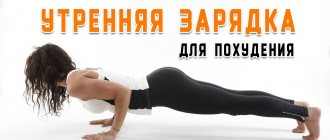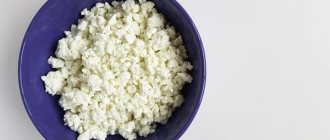What influences body type?
One of the criteria for assessing development and health is the proportionality of the body. If the proportionality is disturbed, then we can assume chromosomal, endocrine disorders that have an impact on the growth process.
The constitution of the human body is a set of characteristics of the body, formed from hereditary and acquired properties, many of which become obvious at an early stage of child development. Some children have a fragile physique, others have an excess of fat tissue over muscle tissue, and still others are endowed with strong muscles.
As you grow older, body features become fixed and by the age of 11 you can determine the type of constitution of the child.
Over the years, scientists have determined body types based on body proportions, but their classification is not an exact science.
- Normosthenic. This type includes people whose body sizes correspond to age parameters.
- Asthenic. People with this body type have elongated limbs, narrow bones, a thin layer of fat, and poorly developed muscles.
- Hypersthenic. In this case, people have well-developed muscles, average height, and transverse dimensions predominate in the existing body proportions.
Classification of species is not an exact science, and there are often many variations within a single “type.” The medical term “physique” includes the constitution, height, and weight of a person.
Practical meaning of the human constitution:
- Medicine. Knowledge of proportions helps diagnose diseases and is used in medical anthropology.
- Physical education. Helps you decide on the choice of sports activities.
- Industrial production. Body parameters are taken into account in the production of clothing and shoes.
Indices and types of bodily proportions
The constitution of the human body is a set of sizes of some parts of the human body and their ratio. One of the common ways to determine proportions is the index method, when the smaller size is determined as a percentage. This method calculates the relative width of the shoulders to the total length of the body and the length of the lower limbs.
Based on calculations, 3 types of human physique were identified:
- Brachymorphic. This species is characterized by powerful, highly developed shoulder muscles, a shortened but wide chest, and a large slope of the pelvic angle. The body of a typical representative may be long, but the height is low due to short legs.
- Dolichomorphic. A representative of this type has elongated limbs and a narrow body. High growth is ensured by long limbs, and these people also have a small pelvic angle.
- Mesomorphic. Determined by the average values of previous species.
The calculation methodology for physical development using indices includes:
- Thoracic height index , I=T– 0.5 L (I – index, T – chest circumference after a sigh, L – body length in cm). For men +5.8, for sports women +3.8 cm.
- Weight-height index , I=P/L (P – weight, L – length). For men = 360-400 g/cm, and for women 320-370 g/cm.
- Vital index , I=VC/P (I – index, vital capacity of the lungs, P – body weight in kg). The male index is 60-62 ml/kg, the female 50-52 ml/kg.
Determining your body type
There are different ways to determine body type. The simplest of them are:
- Visual. Stand in front of the mirror and determine your type based on the main characteristics.
- By measuring the intercostal angle. You need to stand in front of a mirror, place your palms on the branch of the ribs under the sternum and determine the resulting angle by eye. For asthenics it will be sharp (less than 90 degrees), for normosthenics it will be straight (90 degrees), and for hypersthenics it should be blunt (more than 90 degrees).
- According to the Solovyov index, body shape is assessed based on the results of measuring the volume of the wrist with a centimeter tape. Asthenic type: women - up to 15 cm, men - up to 18 cm. Normosthenic: women - from 15 to 17 cm, men - from 18 to 20 cm. Hypersthenic: women - more than 17 cm, men - more than 20 cm.
- In another option, you don’t need to measure your wrist, just grab it with your thumb and forefinger. In asthenics, the fingers overlap, in normosthenics, the fingers are joined, in hypersthenics, the fingers cannot meet.
Regardless of the increase or decrease in a person’s fat and muscle mass, the volume of the wrist remains unchanged. Therefore, this method is quite accurate.
There are other ways to assess the somatotype, for example the Pignier index or the Mark Bricklin method.
Kretschmer's typology of human physique
The German psychiatrist and psychologist E. Kretschmer, in his famous work “Physique and Character,” put forward the theory that certain mental disorders are common among people of certain physical types.
According to the scientist, only genetic factors influence the human constitution. Social reasons do not affect the development of the somatotype. The scheme developed by E. Kretschmer was offered only for men.
He divided personalities into 4 types:
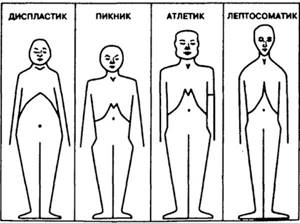
| Somatotypes | Traits inherent to this type |
| Sports or athletic | These people have good skeletal and muscular development and a slender body. Height is average or above average. These people have the personality traits of introverts and are more susceptible to serious mental disorders, schizophrenia. |
| Picnic | People of this type are characterized by large abdominal cavity sizes and numerous fat deposits. Their figure is compact and their height is short. They have the personality traits of extroverts. Such people are more susceptible to mental disorder, manic-depressive psychosis. |
| Asthenic | Tall men with narrow shoulders and underdeveloped muscles fit this type. They are energetic and aggressive, comparable to ambiverts and prone to mental disorders. |
| Leptosomatic | Leptosomatic (from Greek leptos - “fragile”, soma - “body”) - asthenic. The shape of the body is cylindrical, the physique is fragile, the height is tall. The shoulders are narrow, the legs are long and thin. The face is elongated, egg-shaped. |
The psychiatrist suggested that lanky asthenic types, and to a lesser extent athletic types, are more prone to schizophrenia, while picnic types are more prone to developing manic-depressive disorders. His work was criticized, but Kretschmer's ideas to some extent entered popular science and spawned further psychological research.
What types of physiques are there in men, their distinctive features
The term somatotype is used in the classification system of human physical types developed by the American psychologist W. Sheldon. According to his classification system, a person can be correlated with one of the body types: endomorphic or round type, mesomorphic or muscular type, and ectomorphic or thin, linear type.
Sheldon proposed a theory of personality that correlated temperament and body type. He divided people into three categories called "soma types", which were named after the germinal layers of the body of multicellular animals.
- Endomorph. Corresponds to the inner layer, the endoderm, from which the digestive system was formed.
- Ectomorph. The name is compared with the outer ectoderm from which the formation of the skin, glands, and nervous system occurred.
- Mesomorph. The name of the type is derived from the mesoderm, from which the cardiovascular and musculoskeletal systems were formed.

Most people do not have a pure match in somatotype characteristics. A person always has average characteristics that take into account gender, age, and developmental characteristics.
The constitution of the human body is not only external morphological characteristics, but also physiological indices. It is difficult to find pure representatives of all body types, since the indicators of certain parts of the body can be classified with different options.
Ectomorphs
Individuals belonging to this group have the following characteristics:
- thin face with a high forehead and drooping chin;
- narrow chest and toned abdomen, with no subcutaneous fat;
- thin, rather long arms and legs;
- narrow body.
Ectomorphs demonstrate greater social anxiety and introversion, and have the makings of analytical thinking. They have a fast metabolism, which requires more calories and more training. These people are hardy, very flexible and dexterous. A person belonging to this group gains weight easily. If he becomes fat, he is still considered an ectomorph, just overweight.
Endomorphs
An individual of this group is characterized by a round shape, his body is almost spherical, and he also has:
- large round belly;
- large internal organs corresponding to its size;
- rather short limbs;
- full shoulders and hips;
- thin ankles and wrists.
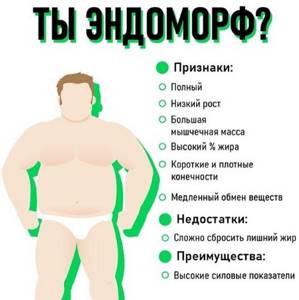
Gains weight easily, has a higher percentage of body fat, and is prone to obesity. Under normal conditions, such a person has a lot of fat, but if he starves, he remains endomorphic, only becomes thinner.
Mesomorphs
This physical type is characterized by good muscle development.
Mesomorphs in their pure form have:
- big head;
- massive muscular chest, shoulders;
- minimum body fat;
- pronounced muscles on the lower and upper limbs;
- excellent posture;
- narrow hips and broad shoulders.
This somatotype easily gains muscle mass, it has strength, speed, and endurance. An example of a mesomorphic person in sports would be a weightlifter, shot putter, or sprinter.
W. Sheldon's technique
One of the founders of somatotyping was Professor W. Sheldon. Back in 1940, he suggested that it is necessary to evaluate not the human physique as a whole, but its individual components. Their combination will determine one or another somatotype, which, according to Sheldon, remains unchanged throughout life. The scientist proposed to evaluate the components using a point system ranging from 1 to 7 (minimum and maximum severity, respectively). This should be done by a trained specialist. Sheldon identified three components:
- endomorphic;
- ectomorphic;
- mesomorphic.

For each of them, a certain value is selected, and the resulting triple of numbers is the somatotype of a particular person. Of course, it is rare to find people who have the maximum score for one component and the minimum for the rest. In most cases, researchers observe average values, among which one component still predominates. Based on Sheldon's research, three human body types are distinguished.
Types and signs of female physiques
The constitution of the female physique was systematized by Professor M.V. Chernorutsky in his works. He identified 3 main types of female body. But the constitutional characteristics of most women cannot be reduced to these three types. This division gives only a general idea of the range of fluctuations in the structure of the human body.
Asthenic appearance
Women in this category have a proportionate figure, long legs, a thin waist, and are of average or slightly above average height. People of this type lack endurance and strength because their muscles are not sufficiently developed. But they are graceful, energetic, and do not tend to be overweight, since the percentage of fat deposits in the body is minimized.
Normosthenic appearance
Normosthenic women have proportional body sizes. This is a balanced and harmonious type of build.
Nature has endowed individuals with such a constitution with fast, sharp movements and well-developed muscle mass. They are slightly taller or average in height, and they rarely develop chronic diseases.
Hypersthenic appearance
Physiological factors that determine women of this type: slightly shortened limbs, the presence of a wide chest, dense bones, height is often below average. A low metabolic rate contributes to rapid weight gain.
Hypersthenic women are hardy and have considerable strength, but lack grace and flexibility.
Types of body constitution according to Ayurveda
Indian traditional medicine, Ayurveda, offers its own idea of the human constitution. According to the teaching, there are three types of body energy, corresponding to the elements of fire, air and earth. They are all present in the human body, but the human constitution is determined by one or two, the dominant ones. They may change over the years, but maintaining the balance of the three elements depends on the person himself.
cotton wool
This type of energy belongs to the element of air. Representatives of Vata are creative, extraordinary individuals. They are fueled by the energy of the air, impulsive, sensitive, and are often visited by feelings of anxiety and restlessness.

They have a refined appearance, a slender, flexible body, and tall stature. According to teaching, such people should maintain energy balance with the help of yoga, Pilates, and race walking.
Pitta
People belonging to the element of fire are decisive, quick-tempered, and have all the signs of a leader. They are ambitious, hardworking to the point of exhaustion, filled with emotion and passion. Often individuals with pitta energy are prone to aggression.
According to Ayurveda, these are fair-skinned people, of average height, with red hair, pointed features. The muscular system is well developed, their height is average. The reason for their frequent aggression is an imbalance in their internal balance, so they are recommended to engage in meditation and water sports.
Kapha
People with predominant kapha energy or the earth element are balanced and calm. They strive to achieve harmony, so they are often characterized by laziness and lack of initiative.
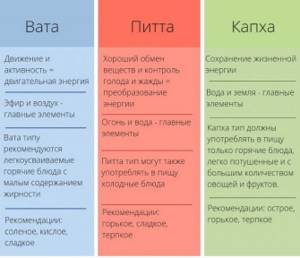
They have a strong build, a round figure, and tend to be overweight. They have a large supply of energy, so they are recommended to do jogging, strength training, and aerobics.
Modern methods of somatotyping
Modern science includes at least 60 somatotyping schemes. For classification, estimates of both the component composition of the body are used: bone, fat, muscle, and overall size.
Typical features of a normosthenic body type
Individuals of this type are characterized by proportional body sizes.
The main parameters of a normosthenic:
- classic body type;
- the muscles are clearly expressed and prominent;
- predisposition to obesity is average;
- good endurance, stable body strength.
The complexion of men and women of this type often looks larger than that of asthenics, but this is due not to fat, but to well-developed muscle tissue. Normosthenics have good health and enhanced metabolism.
Typical features of a hypersthenic body type
Hypersthenics have a slow metabolism, which leads them to rapid weight gain.
The main features of hypersthenic:
- stocky appearance, below average height;
- soft rounded facial features and figures;
- ability to quickly gain weight;
- excess amount of subcutaneous fat.
What role does somatotype play?
Somatotype is the type of human constitution. The somatotype is used to create training programs and select proper nutrition. To maintain your body in good physical shape, you need to be able to determine your somatotype.
At the same time, the shape of the body itself cannot be changed, but it can be transformed by increasing muscles and reducing fat tissue. Regardless of male or female gender, people are divided into:
- on asthenics (hyposthenics) - ectomorphs;
- normosthenics - mesomorphs;
- hypersthenics - endomorphs.
These types of figures differ in bone width, ratio of fat and muscle tissue, and metabolic rate.
How to calculate your body type?
The constitution of the human body is a hereditary program implemented during the individual development of each organism.
To determine the type, you can use one of the following methods:
- Visual method. To do this, you should know the characteristics inherent in the main types of body structure. By looking at the figure, you can visually determine a person’s somatotype.
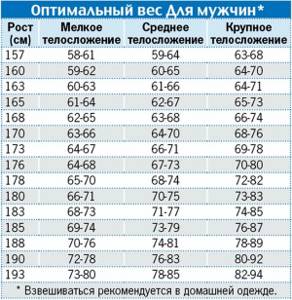
- The relationship between height and weight. A simple formula consists of the difference between the height index and the number 110. The resulting amount approximately corresponds to the ideal weight being measured. And the difference between your own weight and the resulting figure will indicate which somatotype the figure belongs to. All calculations are made with a height of no higher than 170 cm.
- Body measurements and calculations using certain formulas. The most common are the indices of scientists M.V. Chernorutsky, V.P. Chtetsov. To determine it, it is necessary to calculate the girth of the limbs, body mass index, and the size of skin folds.
- Determination of somatotype by wrist size.
Determining body type by wrist
The method of correlating body type by wrist was proposed by the doctor G. A. Solovyov at the beginning of the last century.
The index is based on the thickness of the bones in the wrist area, which can be used to determine your body type:
- ectomorphs – girth is 15–17.5 cm;
- mesomorphs – 17.5–20 cm;
- endomorphs – more than 20 cm.
Typology based on the proportions of body parts
Scientists who study the proportions of the human body understand by them the ratio of transverse, longitudinal, girth and anteroposterior dimensions.
Bodily proportions derived by the scientist P. N. Bashkirov:
| Body type | Body parts relative to length, % | ||||
| Length | Width | ||||
| torso | hand | leg | pelvis | shoulder | |
| Brachymorphic (hypersthenic) | 33,4 | 42,6 | 50,0 | 17,4 | 24,4 |
| Dolichomorphic (asthenic) | 29,6 | 46,6 | 54,1 | 16,1 | 21,4 |
| Mesomorphic (normosthenic) | 31,1 | 44,4 | 52,1 | 16,4 | 23,1 |
Currently, many different tables and programs have been published in which the optimal weight of women and men is calculated, taking into account their constitution.
There are different types of human body types. It has been proven that the constitution of the body does not affect the condition of the body. But knowing your somatic type, you can try to improve it with the help of physical exercise, diet correction, and proper lifestyle.
Author: Belyaeva Anna
Medical practice
There are many classifications based on a person’s physique. The types and characteristics of constitutional features are similar to each other. In medicine, for example, it is customary to focus on the following classification:
— Normosthenic type. It includes people with a proportional body, consistency in the development of the skeletal and muscular systems.
— Asthenic type. Such people have a slender, tall body. Their chest dominates the size of their abdomen, and their limbs are longer when compared with their body. The muscles of people of the asthenic type are poorly developed.
- Hypersthenic type. Such people differ from normosthenics in their shorter stature, dense build, and predominance of transverse dimensions over longitudinal ones.
Every doctor knows the body types of a person and their effect on the condition of the body. Having assessed a person according to his constitution, it is easier for a specialist to determine a tendency to a particular disease and give recommendations regarding lifestyle and treatment methods.






